Septic tank to give without pumping yourself
The desire to relax from the city fuss in nature in a country house or in a country house in comfortable conditions is a natural desire. However, the lack of utilities requires a special approach to the disposal of wastewater and waste. Centralized sewage system or the use of septic tanks with the need for constant pumping for many reasons are not suitable for summer cottages. It is more expedient to assemble an autonomous septic tank to give without pumping. It will make living outside the city comfortable, environmentally friendly and economical.
How to calculate the volume
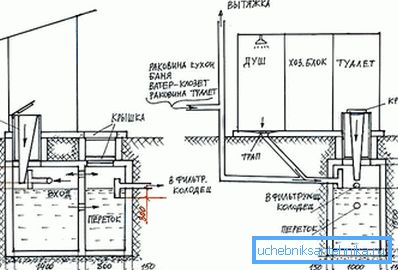
The design of the sewage disposal system for home and garden is identical. Calculate the amount of waste that needs to be cleaned and recycled. This indicator depends on the number of people living and the length of their stay in the country.
Engineering calculation of the septic tank is carried out by a special method. For accommodation of 3-4 people, the useful volume of the section must be at least 2 m3. There should be at least three such cameras in the system. That is, the total net volume will be 6 m3. It is recommended to choose a septic tank with a volume margin of 20–30%. This takes into account the distance from the drain pipe to its top, which is usually in the range of 0.3–0.4 m.
When choosing a cubic device, the inner section size can be 1 m long, 2 m wide and 1–1,2 m high. If you plan to live all year round, you must take into account the depth of soil freezing. That is, it should be insulated, or placed below the level of freezing.
How does it work
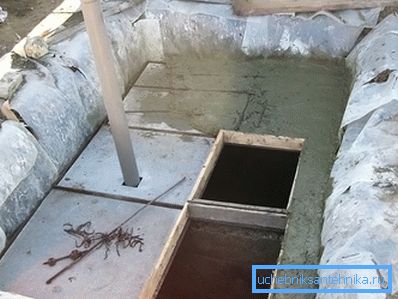
The principle of action of a septic tank without pumping is that in the first two sections, or in all three, there is a biological decomposition of waste under the action of bacteria. Sections, in which the decomposition of wastewater, must be sealed. The organic substance is decomposed into gas and water. The gas comes to the surface through the ventilation pipes, and water and undecomposed waste accumulate and flows through the connecting pipes to the next section. Inorganic compounds settle at the bottom in the form of sludge.
The last section can be used as a full-fledged section for decomposition or as a drainage component of a single system, when two chambers are sufficient for complete biological processing.
If all three sections work as chambers for the decomposition of waste, then a pipe should go out of the last section into the drainage system (or into the filtration field). Purified water will be additionally filtered through layers of sand and gravel. If the last section is used as a drainage chamber, then an additional drainage system is not necessary.
Installation
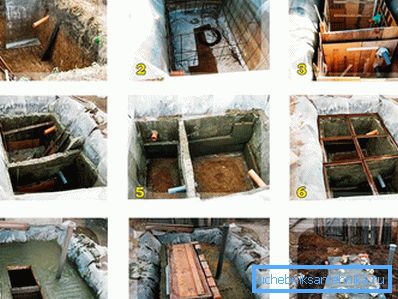
Also, when installing a septic tank, SNiPs should be taken into account according to the choice of the scheme and type of septic tanks, taking into account the characteristics of soils, climatic conditions, and the level of groundwater in order to avoid contamination of aquifers.
Each owner of a country house or a full-fledged residential building should be determined with the design, materials, volume of a septic tank.
For self-build autonomous systems use either ready-made concrete rings, or pour the concrete structure independently. How these septic tanks look can be seen in the photo.
The use of bricks as materials for walls is impractical, since the service life of the system is sharply reduced and it is impossible to guarantee the tightness of the sections.
The choice of the location of this device must comply with sanitary standards. The minimum distance from the house and other buildings should be 5 m. To the water supply sources, removal is required by 20–50 m. The distance is determined by the properties of the soil: the better its capacity, the greater it will be.
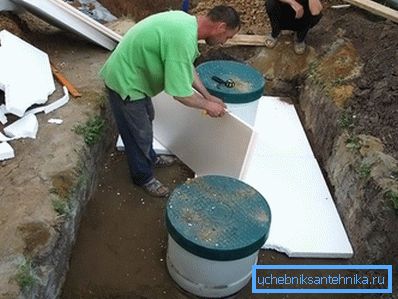
After selecting the location of the device digs the pit. Its depth is calculated taking into account the occurrence of sewer pipes and the level of soil freezing. The perimeter of the pit should exceed the perimeter of the septic tank, taking into account the free installation of concrete rings or formwork for self-pouring the structure with concrete. As the external formwork can serve as pre-aligned vertical walls of the pit. But in this case, the walls of the soil must be isolated from the concrete mix with roofing material or polyethylene.
When installing ready-made concrete rings, you will need a cargo transport for transportation, as well as a crane for installation. This option requires additional financial costs for special equipment, but reduces the complexity of self-pouring concrete walls.
The bottom and walls of the excavation must be leveled and put a sand cushion 20-30 cm thick. The formwork is installed around the perimeter of the future septic tank to a height of 20 cm. It is constructed from a cut board and bars, blocked from the outside from the boards into the ground. Thus, the boards will not diverge when pouring concrete. Roofing material or polyethylene is placed inside the formwork so that the cement milk will not be absorbed into the sand pad.
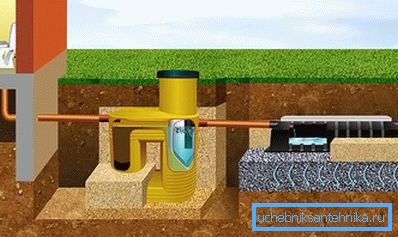
Next fit the reinforcement or reinforcement mesh over the entire area. The grid with a cell of 200 by 200 mm and a diameter of reinforcement of 6 or 8 mm is placed on special supports (stones, pieces of brick, concrete) so that there is a distance of 30 mm from it to the sand cushion.
In the places where the walls of the septic tank will be located, pieces of reinforcement are installed in a vertical position so that the ends of the bars come out of the plate by 50–80 cm. This is necessary for a monolithic connection of the bottom with the walls of the device.
The stove is poured with concrete solution grade B15. Flooded concrete must be compacted with a vibrator. On the next day after pouring, the leveled bottom begins to be watered with water and covered with cellophane or rags to build strength. After 14 days, you can proceed to the construction of the walls of the device.
The wall thickness of the septic tank should be at least 20 cm, and the partitions should be 15 cm. Wall formwork should be constructed from boards made of edged boards, OSB panels, and waterproof plywood. It is advisable to fill the walls at once at full height. In the absence of a sufficient number of necessary materials, use a sliding formwork from small shields, moving them upwards in 30–40 cm. The formwork must be securely fixed on the slab, otherwise it will be squeezed out or raised with mortar. To prevent this from occurring, additional spacers are installed inside the opposite walls of the device. Before installing the formwork, reinforcement mesh for walls with a cell of 200 by 200 mm is tied to reinforcement sticking out of the slab. Do not forget to equip the play of the chambers, the incoming and outgoing holes for sewer pipes. The walls are also poured with concrete grade B15. The walls must be compacted with a vibrator so that there are no voids that reduce the strength of concrete.
After 14 days, you can begin to install formwork for the top of our device. Installation of the formwork is carried out from the available materials, by analogy with the walls, only put struts between the formwork and the bottom of the septic tank. Do not forget to build a viewing hole. It will serve to access. The formwork must be collapsible so that after pouring it can be disassembled and pulled out. Reinforced and poured top by analogy with the walls and the bottom.
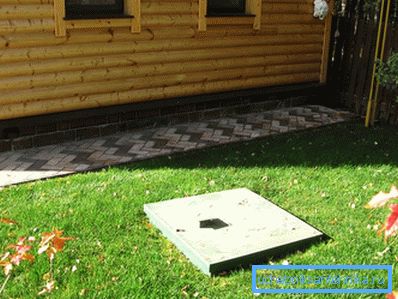
After the strength of the concrete is established, we connect the whole sewer system with pipes and seal the joints. The septic tank is filled with sand outside and insulated if necessary. The construction process can be visually viewed in the video.
A photo

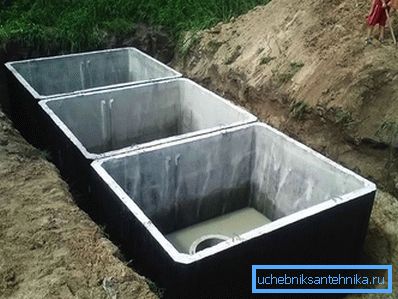
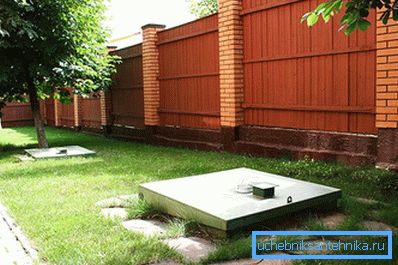
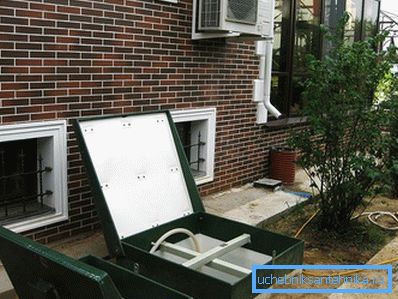




Scheme
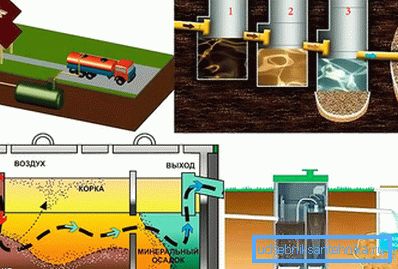

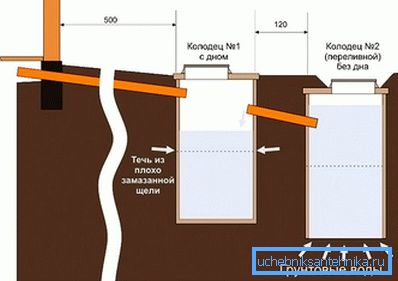
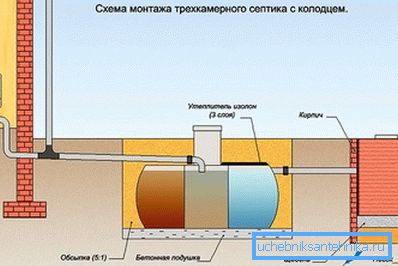
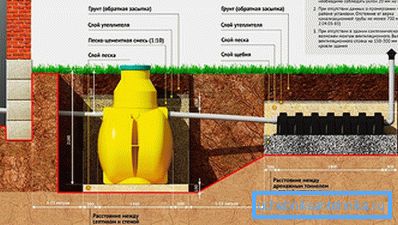
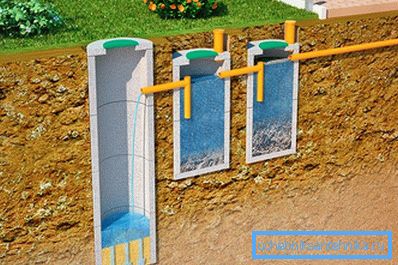
Video
This video shows how to properly install a septic tank without pumping with your own hands: